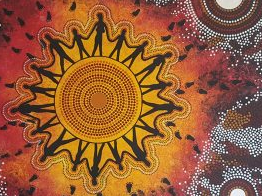
URPoint Details
Archerfield's Indigenous history in brief
ARCHERFIELD's original inhabitants were the Yerongpan clan who spoke a dialect of the Turrbal language.
According to the State Library of Queensland, Yerongpan – also written as Yerongban or Yeronghan [See AIATSIS Language Code E23] – was thought to have been the dominant clan in the area.
The site where the airfield is today would have been carefully curated for food and wildlife by the clan. Possibly this landscape may have originally attracted settlers to farm the area.
The State Library of Queensland has ascertained that the languages of Brisbane are related with many shared/borrowed words. Traditionally individuals spoke several languages including their parents’ languages and neighbouring languages.
The languages to the north of Brisbane CBD have a relationship to Kabi Kabi and Wakka Wakka. The Moreton Bay and Brisbane area languages are also linked. To the south, Yugambeh shared more in common with Bundjalung.
Archerfield Airport Corporation's First Nations research
IN 2021 AAC completed the Archerfield Airport Heritage Management Plan (HMP) (Australian Heritage Specialists, 2021), replacing the earlier Cultural Heritage Assessment and Management Plan: Archerfield Airport, Brisbane (Bonhomme Craib and Associates, 2001).
The management plan addresses both Aboriginal cultural heritage and built heritage.
Aboriginal cultural heritage
Prior to the arrival of Europeans in Australia, Aboriginal people inhabited the entirety of mainland Australia and associated islands, and their beliefs held that they had occupied this land since the beginning of time. Archaeological evidence shows that Aboriginal people have inhabited south-east Queensland for at least 20,000 years; however, it is expected that their occupation extends earlier than this date.
The airport is located in the traditional lands of people who spoke the Yuggera language (also known as Yagara or Jagera), which includes the Turrbal speakers. The Yagara language was spoken along most of the Brisbane River from the foot of the ranges to Moreton Bay, encompassing the "Sandy country" (Yerongpan) between Brisbane and Ipswich, which included the Brisbane River from the Cleveland district inland to the Dividing Range about Gatton, north to near Esk, at Ipswich, and as far afield as Cunningham's Gap in the Fassifern District and Murphy's Creek at the head of the Lockyer Creek.
It is possible the Turrbal name was also used for an alliance of Yagara speakers including the Turrbal and others south of the river as far as the Logan River. The word tarau in the Yagara language refers particularly to loose stones, and the name Taraubul is evidently derived from the geological nature of the Brisbane area, the formation of which is almost entirely of brittle schist.
At the time of convict settlement in the Moreton Bay region, it was estimated that some tens of thousands of Aboriginal peoples lived near what is now known as the Brisbane River, using their established pathways to attend gatherings and visit ceremonial sites.
Huge gatherings often took place on neutral territory, acknowledged by all clans as meeting areas.
It is believed these people were known as the Coorpooroo Clan (residing on the south bank of the Brisbane River), the Yerongpan Clan (residing along Oxley Creek in the vicinity of Brown’s Plains, along the Mount Lindsay Highway), and the Chepara Clan (residing in the Eight Mile Plains area).
Although the Oxley Creek area was recorded as the traditional lands of the Yerongpan Clan, ethnographic records do not elaborate on whether their boundary extended north as far as the airport.
The airport site has been highly disturbed since European occupation of the area as a result of land clearance, stock grazing, and establishment of the airport in the late 1920s to 1930s, and ongoing development of the airport and surrounding land.
The first Europeans arrived in the Acacia Ridge area in the 1820s but the area remained mostly rural well into the 20th Century. The airport site has been highly disturbed since European occupation of the area as a result of land clearance, stock grazing, and establishment of the airport in the 1930s.
The previous HMP (Bonhomme Craib and Associates, 2001) undertook a Cultural Heritage Assessment for Aboriginal Cultural Heritage, which included searching relevant literature and registers, and also included consultation with Aboriginal groups, Native Title claimants, and other Indigenous interest groups. An archaeological field survey was also undertaken which informed the recommendations and management measures of the previous HMP.
The previous heritage assessment included a search of relevant literature, registers, and other data; identification and consultation with Aboriginal traditional owners, Native Title claimants and other indigenous interest groups; archaeological field surveys and preparation of recommendations and a Cultural Heritage Management Plan for the airport.
The study did not locate any sites or features of cultural heritage significance, and found that the majority of the airport land has no potential for in-situ Aboriginal Cultural Heritage.
The 2021 HMP includes an Aboriginal Cultural Heritage Archaeological Potential Plan, and this has been incorporated into Figure 28 Heritage Management Plan.
Consistent with the 2001 HMP, an area with Low Aboriginal Cultural Heritage potential was identified along Oxley Creek to the south-west corner. It is noted that parts of this area have been subject to significant ground disturbance, including disturbance caused by the construction of the stormwater detention basin and drains in the vicinity of Oxley Creek, and these portions do not have potential for in-situ archaeology to exist.
This part of the airport is designated in the Master Plan as a conservation area.
#
- Type:
- Indigenous
- Establishment year:
- 1850
- Keywords:
- Attachments:
Map Location
Price List
-
 $0.00
$0.00















